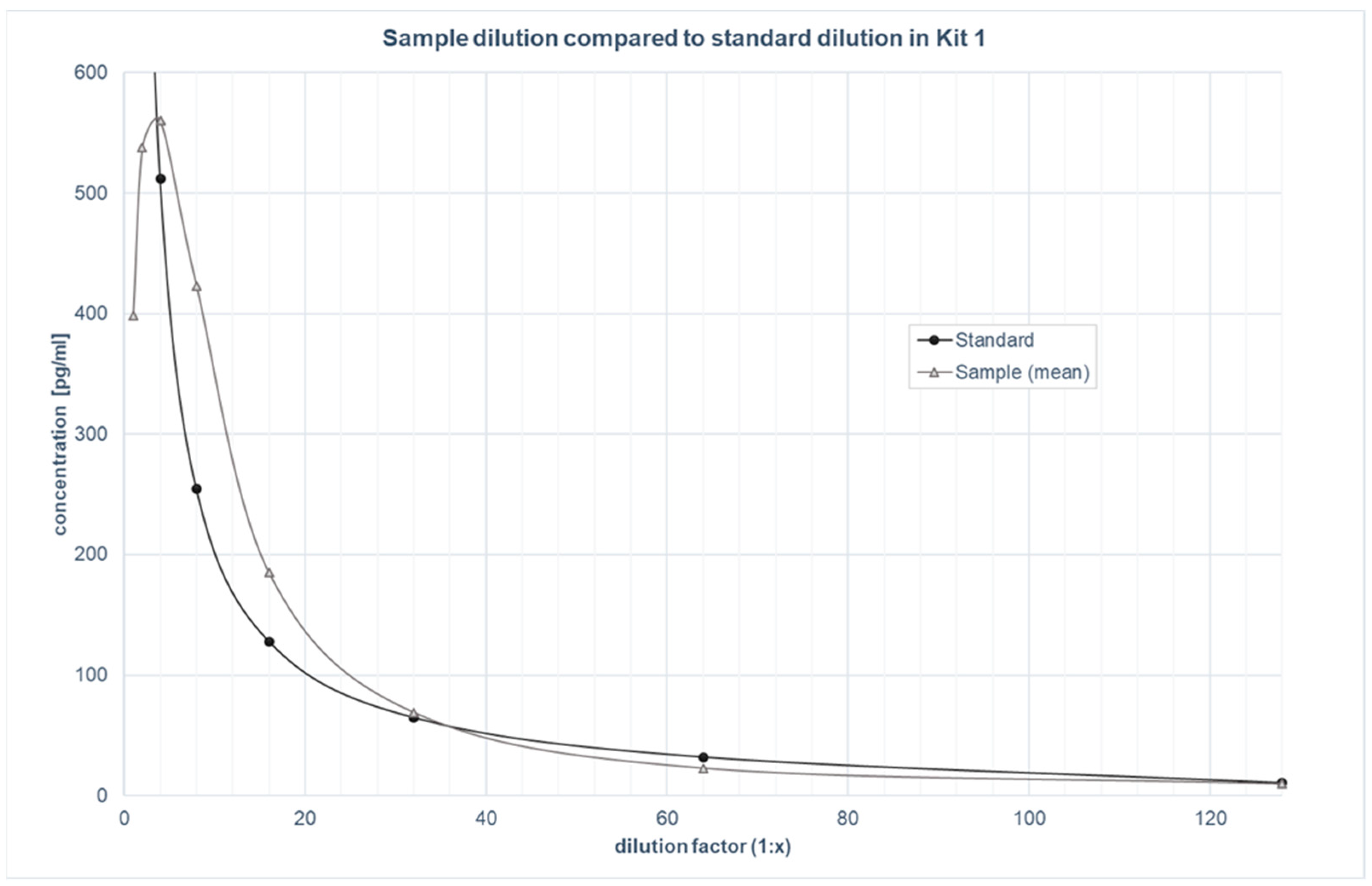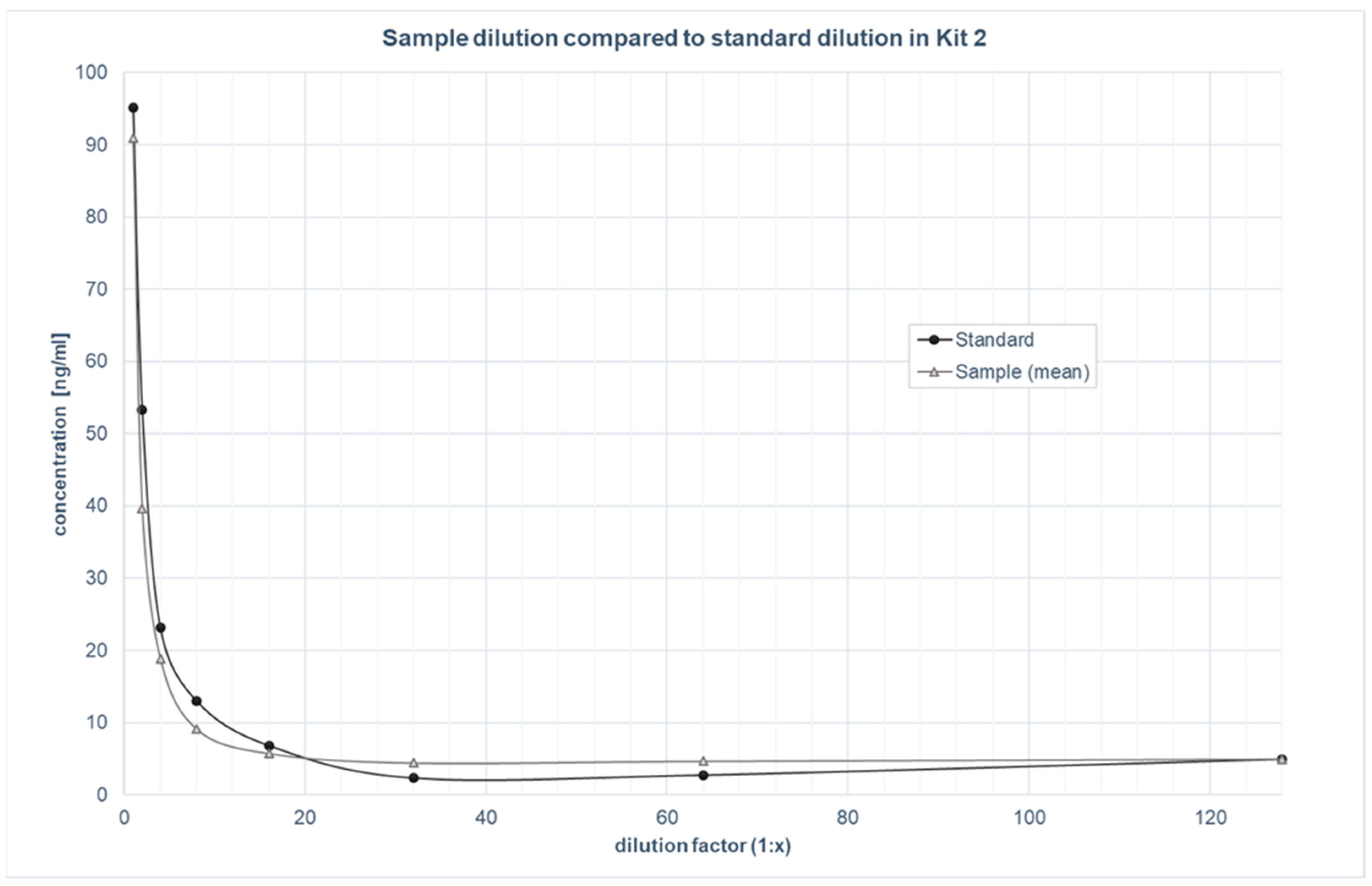Validation of a Commercial Enzyme-Linked Immunosorbent Assay for Allopregnanolone in the Saliva of Healthy Pregnant Women
Abstract
:1. Introduction
2. Materials and Methods
2.1. Study Design and Procedure
2.2. Participants
2.3. ELISA Kit
2.4. Validation Parameters
2.5. LC–MS vs. ELISA Method Comparison
3. Results
3.1. Intra- and Inter-Assay Precision
3.2. Assay Range and Sensitivity
3.3. Parallelism
3.4. Linearity of dilution
3.5. Recovery
3.6. LC-MS vs. ELISA Method Comparison
4. Discussion
5. Conclusions
Author Contributions
Funding
Institutional Review Board Statement
Informed Consent Statement
Data Availability Statement
Acknowledgments
Conflicts of Interest
Appendix A
Appendix A.1. LC-MS/MS Method
Appendix A.1.1. Materials and Chemicals
Appendix A.1.2. Sample Preparation
Appendix A.1.3. Chemical Analysis
| Compound Name | RT (min) | Precursor Ion (m/z) a | MS1 Res | Product Ion (m/z) | MS2 Res | Dwell Time (ms) | Fragmentor Voltage | CE (V) | Polarity | Limit of Detection b |
|---|---|---|---|---|---|---|---|---|---|---|
| Allopregnanolone | 4.076 | 301.2 | Wide | 283.2 | Unit | 95 | 85 | 12 | + | 0.3 |
| Wide | 189.2 | Unit | 95 | 85 | 21 | + |
References
- Karashima, S.; Osaka, I. Rapidity and Precision of Steroid Hormone Measurement. J. Clin. Med. 2022, 11, 956. [Google Scholar] [CrossRef]
- Engvall, E.; Perlmann, P. Enzyme-linked immunosorbent assay (ELISA) quantitative assay of immunoglobulin G. Immunochemistry 1971, 8, 871–874. [Google Scholar] [CrossRef]
- Metcalfe, S.S.; Kroon, F.J.; Beale, D.J.; Miller, G. Development of a validation protocol of enzyme immunoassay kits used for the analysis of steroid hormones in fish plasma. J. Exp. Mar. Biol. Ecol. 2018, 499, 26–34. [Google Scholar] [CrossRef]
- Walker, J.M.; Crowther, J.R. The ELISA Guidebook; Humana Press: Totowa, NJ, USA, 2009; ISBN 978-1-60327-253-7. [Google Scholar]
- Kaleta, M.; Oklestkova, J.; Novák, O.; Strnad, M. Analytical Methods for the Determination of Neuroactive Steroids. Biomolecules 2021, 11, 553. [Google Scholar] [CrossRef]
- Sakamoto, S.; Putalun, W.; Vimolmangkang, S.; Phoolcharoen, W.; Shoyama, Y.; Tanaka, H.; Morimoto, S. Enzyme-linked immunosorbent assay for the quantitative/qualitative analysis of plant secondary metabolites. J. Nat. Med. 2018, 72, 32–42. [Google Scholar] [CrossRef]
- Gröschl, M.; Biskupek-Sigwart, J.; Rauh, M.; Dörr, H.G. Measurement of Cortisol in Saliva Using a Commercial Radioimmunoassay Developed for Serum. Messung von Speichel-Cortisol mittels eines kommerziellen Serum-Radioimmunoassays. Lab. Med. 2000, 24, 314–318. [Google Scholar] [CrossRef]
- Valentin, M.-A.; Ma, S.; Zhao, A.; Legay, F.; Avrameas, A. Validation of immunoassay for protein biomarkers: Bioanalytical study plan implementation to support pre-clinical and clinical studies. J. Pharm. Biomed. Anal. 2011, 55, 869–877. [Google Scholar] [CrossRef]
- Temerdashev, A.; Dmitrieva, E.; Podolskiy, I. Analytics for steroid hormone profiling in body fluids. Microchem. J. 2021, 168, 106395. [Google Scholar] [CrossRef]
- Chiappin, S.; Antonelli, G.; Gatti, R.; de Palo, E.F. Saliva specimen: A new laboratory tool for diagnostic and basic investigation. Clin. Chim. Acta 2007, 383, 30–40. [Google Scholar] [CrossRef]
- Granger, D.A.; Taylor, M.K. Salivary Bioscience; Springer International Publishing: Cham, Switzerland, 2020; ISBN 978-3-030-35783-2. [Google Scholar]
- Hoyt, M.A.; Granger, D.A. Salivary Bioscience and the Future of Behavioral Medicine. Int. J. Behav. Med. 2020, 27, 257–261. [Google Scholar] [CrossRef]
- McEvoy, K.; Osborne, L.M. Allopregnanolone and reproductive psychiatry: An overview. Int. Rev. Psychiatry 2019, 31, 237–244. [Google Scholar] [CrossRef]
- Meltzer-Brody, S.; Kanes, S.J. Allopregnanolone in postpartum depression: Role in pathophysiology and treatment. Neurobiol. Stress 2020, 12, 100212. [Google Scholar] [CrossRef]
- Reddy, D.S. Neurosteroids: Endogenous role in the human brain and therapeutic potentials. Prog. Brain Res. 2010, 186, 113–137. [Google Scholar] [CrossRef]
- Ali, M.; Aamir, A.; Diwan, M.N.; Awan, H.A.; Ullah, I.; Irfan, M.; de Berardis, D. Treating Postpartum Depression: What Do We Know about Brexanolone? Diseases 2021, 9, 52. [Google Scholar] [CrossRef]
- Cerne, R.; Lippa, A.; Poe, M.M.; Smith, J.L.; Jin, X.; Ping, X.; Golani, L.K.; Cook, J.M.; Witkin, J.M. GABAkines—Advances in the discovery, development, and commercialization of positive allosteric modulators of GABAA receptors. Pharmacol. Ther. 2022, 234, 108035. [Google Scholar] [CrossRef]
- Luisi, S.; Petraglia, F.; Benedetto, C.; Nappi, R.E.; Bernardi, F.; Fadalti, M.; Reis, F.M.; Luisi, M.; Genazzani, A.R. Serum allopregnanolone levels in pregnant women: Changes during pregnancy, at delivery, and in hypertensive patients. J. Clin. Endocrinol. Metab. 2000, 85, 2429–2433. [Google Scholar] [CrossRef]
- Pearson Murphy, B.E.; Steinberg, S.I.; Hu, F.Y.; Allison, C.M. Neuroactive ring A-reduced metabolites of progesterone in human plasma during pregnancy: Elevated levels of 5 alpha-dihydroprogesterone in depressed patients during the latter half of pregnancy. J. Clin. Endocrinol. Metab. 2001, 86, 5981–5987. [Google Scholar] [CrossRef]
- Chen, S.; Gao, L.; Li, X.; Ye, Y. Allopregnanolone in mood disorders: Mechanism and therapeutic development. Pharmacol. Res. 2021, 169, 105682. [Google Scholar] [CrossRef]
- Gildner, T.E. Reproductive hormone measurement from minimally invasive sample types: Methodological considerations and anthropological importance. Am. J. Hum. Biol. 2021, 33, e23535. [Google Scholar] [CrossRef]
- Andreasson, U.; Perret-Liaudet, A.; van Waalwijk Doorn, L.J.C.; Blennow, K.; Chiasserini, D.; Engelborghs, S.; Fladby, T.; Genc, S.; Kruse, N.; Kuiperij, H.B.; et al. A Practical Guide to Immunoassay Method Validation. Front. Neurol. 2015, 6, 179. [Google Scholar] [CrossRef]
- Chan, C.C.; Lam, H.; Lee, Y.C.; Zhang, X.-M. Analytical Method Validation and Instrument Performance Verification; John Wiley & Sons, Inc.: Hoboken, NJ, USA, 2004; ISBN 9780471463726. [Google Scholar]
- European Medicines Agency. Guideline on Bioanalytical Method Validation; European Medicines Agency: London, UK, 2015. [Google Scholar]
- Jaedicke, K.M.; Taylor, J.J.; Preshaw, P.M. Validation and quality control of ELISAs for the use with human saliva samples. J. Immunol. Methods 2012, 377, 62–65. [Google Scholar] [CrossRef]
- Cross, T.G.; Hornshaw, M.P. Can LC and LC-MS ever replace immunoassays? J. Appl. Bioanal. 2016, 2, 108–116. [Google Scholar] [CrossRef]
- Kirschbaum, C.; Tietze, A.; Skoluda, N.; Dettenborn, L. Hair as a retrospective calendar of cortisol production-Increased cortisol incorporation into hair in the third trimester of pregnancy. Psychoneuroendocrinology 2009, 34, 32–37. [Google Scholar] [CrossRef]
- DeSilva, B.; Smith, W.; Weiner, R.; Kelley, M.; Smolec, J.; Lee, B.; Khan, M.; Tacey, R.; Hill, H.; Celniker, A. Recommendations for the bioanalytical method validation of ligand-binding assays to support pharmacokinetic assessments of macromolecules. Pharm. Res. 2003, 20, 1885–1900. [Google Scholar] [CrossRef]
- Tu, J.; Bennett, P. Parallelism experiments to evaluate matrix effects, selectivity and sensitivity in ligand-binding assay method development: Pros and cons. Bioanalysis 2017, 9, 1107–1122. [Google Scholar] [CrossRef]
- Mayne, G.; de Bloois, E.; Dabelea, D.; Christians, U. Development and validation of an LC-MS/MS assay for the quantification of allopregnanolone and its progesterone-derived isomers, precursors, and cortisol/cortisone in pregnancy. Anal. Bioanal. Chem. 2021, 413, 5427–5438. [Google Scholar] [CrossRef]


| Characteristics | Kit 1 (UNEB0081) | Kit 2 (UNFI0053) |
|---|---|---|
| Assay range | 31.2–2000 pg/mL | 1.563–100 ng/mL |
| Sensitivity | <9.5 pg/mL | 0.938 ng/mL |
| Assay type | competitive | competitive |
| Intra-assay precision | 3.4% | <8% |
| Inter-assay precision | 5.6% | <10% |
| Linearity of dilution | 80–120% | 88–105% |
| Recovery | 102% | 94% |
| Parameter | Description | Acceptance Criteria | Formula |
|---|---|---|---|
| Intra-assay precision | Reproducibility between wells within one assay plate | <10% | %CV = SD/M × 100 |
| Inter-assay precision | Reproducibility between wells between assay plates, done on different days | <15% | %CV = SD/M × 100 |
| Sensitivity | The lowest signal that can be distinguished from the background | none | = MOD + 2 SD |
| Parallelism | Provides confirmation that the analyte is recognised in the natural sample in the same way as in the standards, measured with neat samples | 75–125% | %Parallelism = (measured concentration/(previous measured value in the dilution series/dilution factor)) × 100 |
| Linearity of dilution | Used to determine whether dilution of the analyte is affected by dilution of sample matrices, measured with spiked samples | 70–130% | %Linearity = (measured concentration/(previous measured value in the dilution series/dilution factor)) × 100 |
| Recovery | Used to determine whether analyte detection is affected by differences in sample matrices, measured with spiked and neat samples | 80–120% | %Recovery = ((measured concentration spiked sample—measured concentration neat sample)/theoretical concentration spiked) × 100 |
| Parameter | Acceptance Criteria | Kit 1 (UNEB0081) | Kit 2 (UNFI0053) |
|---|---|---|---|
| Intra-assay precision | <10% | 7.9% | 5.9% |
| Inter-assay precision | <15% | 10.8% | 7.3% |
| Parallelism | 75–125% | 104.3% | 116.9% |
| Linearity of dilution | 70–130% | 76.2% | 107.5% |
| Recovery | 80–120% | 116.5% | 149.5% |
Publisher’s Note: MDPI stays neutral with regard to jurisdictional claims in published maps and institutional affiliations. |
© 2022 by the authors. Licensee MDPI, Basel, Switzerland. This article is an open access article distributed under the terms and conditions of the Creative Commons Attribution (CC BY) license (https://creativecommons.org/licenses/by/4.0/).
Share and Cite
Grötsch, M.K.; Wietor, D.M.; Hettich, T.; Ehlert, U. Validation of a Commercial Enzyme-Linked Immunosorbent Assay for Allopregnanolone in the Saliva of Healthy Pregnant Women. Biomolecules 2022, 12, 1381. https://doi.org/10.3390/biom12101381
Grötsch MK, Wietor DM, Hettich T, Ehlert U. Validation of a Commercial Enzyme-Linked Immunosorbent Assay for Allopregnanolone in the Saliva of Healthy Pregnant Women. Biomolecules. 2022; 12(10):1381. https://doi.org/10.3390/biom12101381
Chicago/Turabian StyleGrötsch, Maria Katharina, Denise Margret Wietor, Timm Hettich, and Ulrike Ehlert. 2022. "Validation of a Commercial Enzyme-Linked Immunosorbent Assay for Allopregnanolone in the Saliva of Healthy Pregnant Women" Biomolecules 12, no. 10: 1381. https://doi.org/10.3390/biom12101381
APA StyleGrötsch, M. K., Wietor, D. M., Hettich, T., & Ehlert, U. (2022). Validation of a Commercial Enzyme-Linked Immunosorbent Assay for Allopregnanolone in the Saliva of Healthy Pregnant Women. Biomolecules, 12(10), 1381. https://doi.org/10.3390/biom12101381









